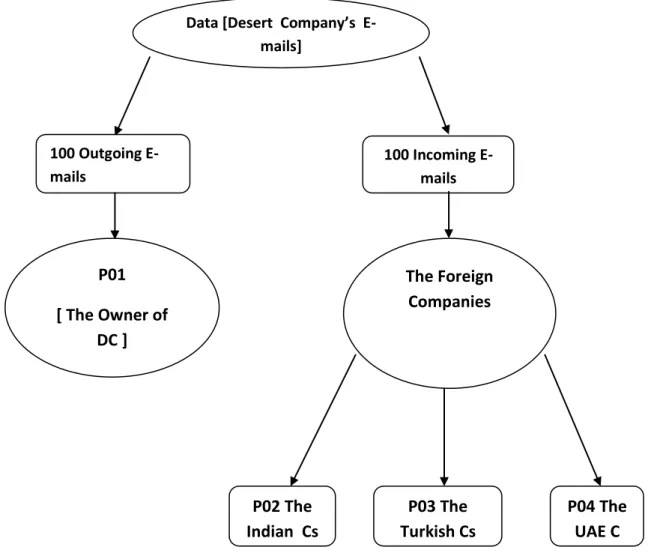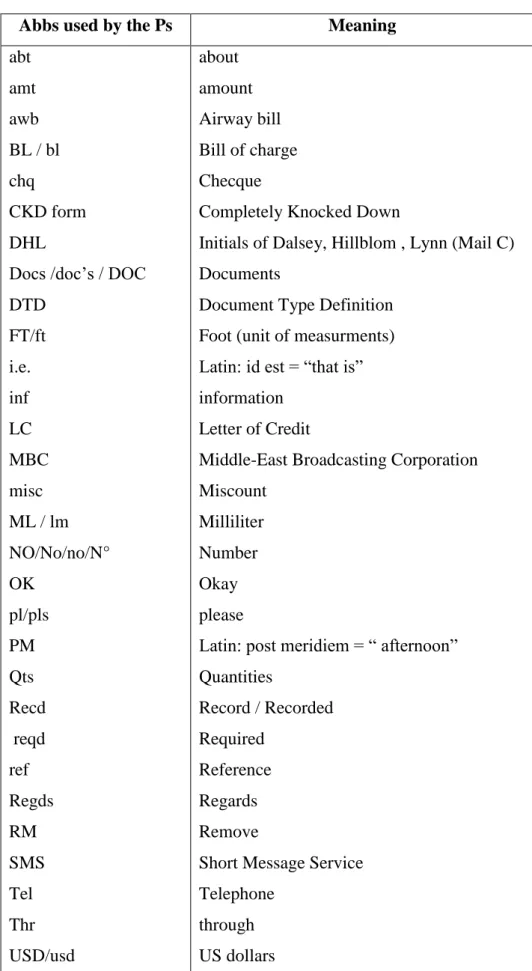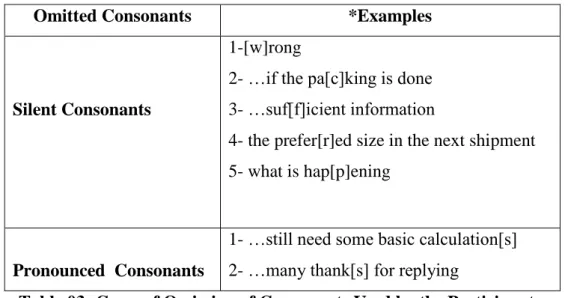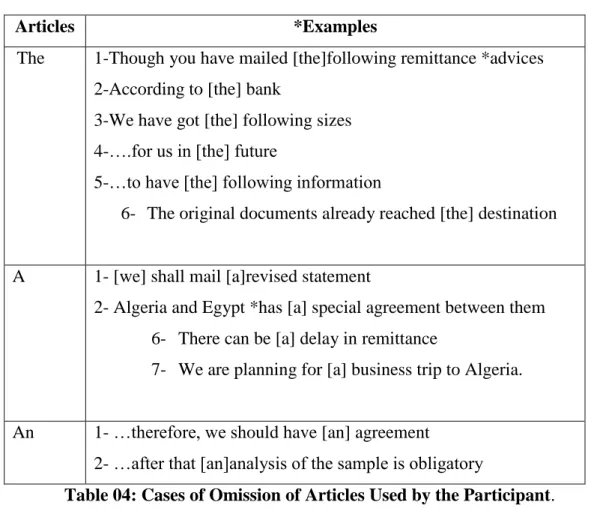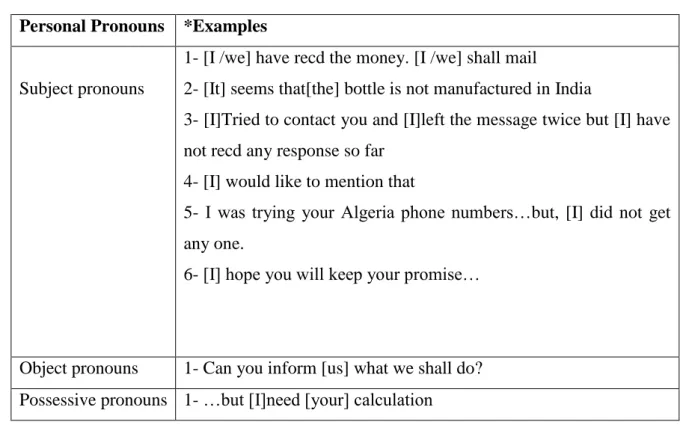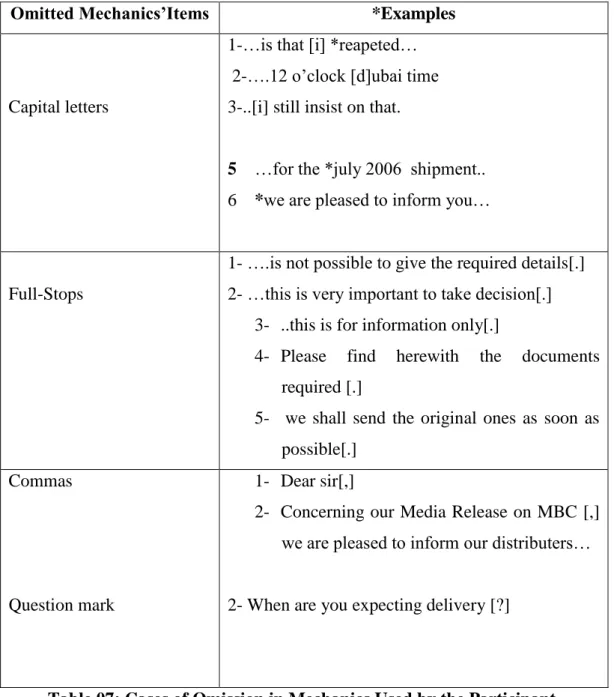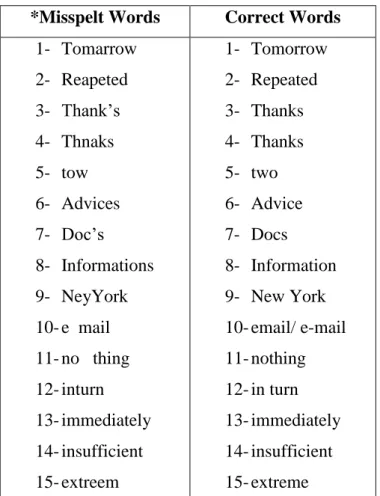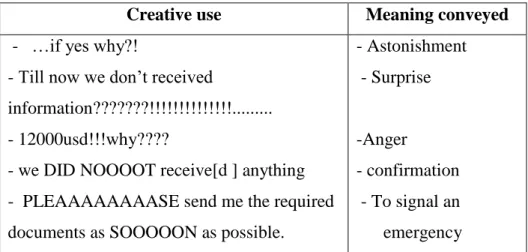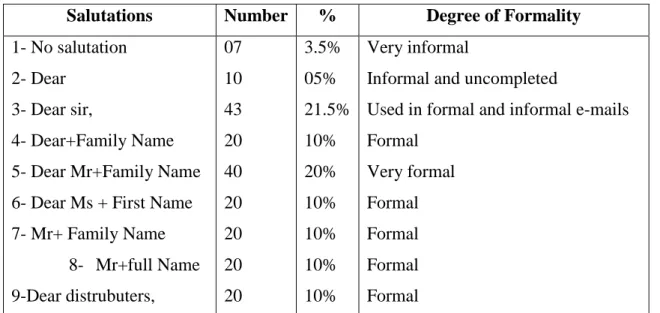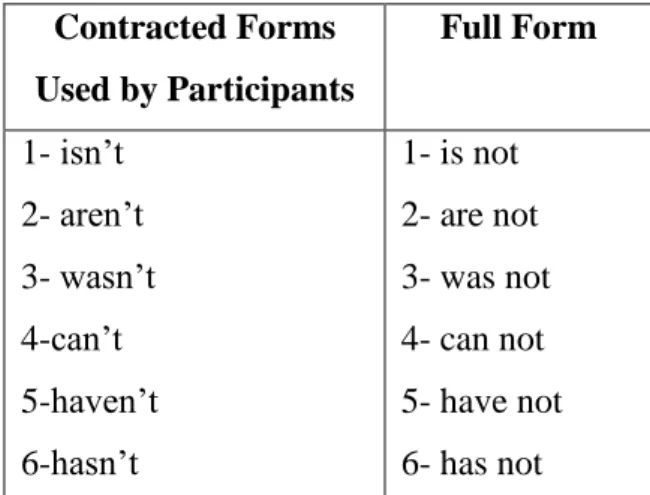Colloque International
Les Discours Spécialisés : enjeux, descriptions et pratiques
19, 20 et 21 octobre 2016
À l’Institut Supérieur des Langues de Gabès (Tunisie)
en partenariat avec le Laboratoire LLTA
(DS.edp 19, 20 et 21 octobre 2016) Université de Gabès-Tunisie
Colloque International
Les discours spécialisés : enjeux, descriptions et pratiques
L’Institut Supérieur des Langues de Gabès (ISLG) en partenariat
avec le Laboratoire de recherche LLTA
19 – 20 – 21 octobre 2016
Article about
Investigating the Linguistic Features of the E-mailing Discourse
Axe Choisis : Axe 01 : Description Linguistique et analyse des discours spécialisés (caractéristiques
typographiques, lexicales, morphosyntaxiques, sémantiques, pragmatiques, etc.)
Prepared by :
Miss NESBA Asma & Mr. GHEDEIR BRAHIM Mohammed
Abstract
The present study aims at investigating the linguistic features of the E-mailing discourse, being a part of a wider discourse, the electronic discourse. It is a specialized discourse that disposes certain characteristics that guarantees its distinctiveness from other types of Englishes such as political English, legal English and Medical English. These differences are shown on different linguistic levels: typographical level, lexical level, syntactic level and discourse level. A Corpus analysis of a number of 200 e-mail messages from the routine communication in work context of a private import-export company in El Oued, working as a franchisee for important international franchisors, is conducted: 100 outgoing e-mails composed by the first participant, the owner of the company and 100 incoming e-mails written by the representatives of foreign companies ( Indian Cs, Turkish Cs and a UAE C). A qualitative, descriptive and critical corpus analysis is followed based on linguistic criteria. The findings reveal that the company‟s e-mail language is characterized mainly by a linguistic economy in the form of chatting abbreviations, acronyms, structural reductions, ellipsis, clippings and orthographic reduction; a linguistic innovation in the form of creative use of capitalization, spelling and punctuation to convey effects of gesture and tone as well as oral features and informality in the form of informal greetings and leave-takings. Results of the analysis are used to suggest recommendations to signal the importance of pedagogy in instructing students to use CMC properly without feeling the fear from the new technology. Students must be instructed both the well constructed texts used in academic settings as well as the specific texts used for personal interactions. E-mailing for academic and occupational purposes is different from e-mailing for maintaining social relations.
Keywords : Specialized discourse - electronic discourse – E-mailing dicourse –CMC – CMD
RESUME
Cette recherche est une étude descriptive, analytique et critique qui à pour but de réaliser
une description linguistique et une analyse d‟un discours spécialisé, les e-mails (ou courriels commerciaux , qui porte sur les caractéristiques typographiques, lexicales, morphosyntaxiques et discursive.
L‟étude porte sur une entreprise d‟import –export située à la ville d‟El-Oued qui porte le nom de « Desert Copmany » (pseudonyme) fonctionnant comme distributeur exclusif en Algérie pour des entreprises étrangères connues.
Une analyse de corpus a été faite sur 200 e-mails de la routine quotidienne du travail, volontairement remis par le propriétaire de l‟entreprise. Ces mails se composent de 100 e-mails envoyés écrits par le propriétaire de l‟entreprise ainsi que d‟autre 100 e-e-mails reçus écrits par les représentants des entreprises étrangères: entreprises indiennes, des autre turques et une autre émiratie.
Les résultats de l‟analyse ont démontré que le langage e-mail contient des traits particuliers. Il s‟agit d‟une certaine économie langagière sous forme d‟abréviation et d‟omission ainsi que la présence de critères typographiques tel que l‟utilisation créative de la ponctuation et de majuscules.. En outre on a inscrit la présence du style oral et conversationnel ainsi que les marques indiquant l‟appartenance culturelle et sociale de l‟auteur des e-mails.
La discussion et l‟interprétation des résultats ont procuré la proposition de réaliser un programme de long terme pour les étudiants de l‟anglais de spécialité dans des différentes branches pour les faire connaitre la différence entres les e-mails personnels et les e-mails professionnels.
Introduction
The specialized discourse is a special language that disposes certain characteristics that make it distinctive. The study of the specialized discourse can be fruitful in many ways. First it enables us to detect the linguistic levels subject to the differentiation from that of the general English. Second, it can be of a great interest to the language practionners in its instruction since it gives insights into how that special langage can be taught adopting the genre based approach. Last but not least it is of a great inportance in the professional settings for it can speed up the learning of a special type of language ; and a new learner or the non initiated will be easily and quikly adhered to a given discourse community. The e-mail discourse ; being a part of a wider discourse, the electronic discourse; is a special discourse that is worth investigating for its importance in achieving different communicative purposes in both the academic and the professional settings and namely in maintaining social relationships. In fact the discourse community of this genre can be considered as the widest one since e-mailing is becoming an integral part of our daily routine. This can engender in having many genres within the same genre, subgenres. In the work context, e-mailing is becoming a very important tool of communication. Big companies set some programmes to instruct their employees how to compose professional e-mails that meet the company‟s needs.
The present study inspires from the works of David crystal‟s detailed analysis of the electronic discourse. The present paper aims at finding answers to the following questions
1- What are the e-mails‟ lingistic levels that are subject to differenciation ? 2- Are e-mails considered as a specialized discourse ?
3- How can CMC be used properly to write prfessional e-mails ?
4- What difference can be drawn between e-mailing for academic and occupational purposes, and e-mailing for maintainning social relations ?
1. Literature Review
1.1 Definition of Specialized discourse
Discourse has a various definitions. One of them is: „a type of language used in specific kinds of writing or speech‟. It is also defined as any unit of connected speech or writing longer than a sentence.
Discourse in context may consist of only one or two words as in stop or no smoking. Alternatively, a piece of discourse can be hundreds of words in length, as some novels are. A typical piece of discourse is somewhere between those two extremes.
Lawrence Erlbaum (2002 p:22)
Specialized discourse differs from general language at all levels of analysis quantitatively (frequency of occurrences) and qualitatively (specific use).
The specialized language is different from the so called general language regarding lexical, semantic, grammatical, stylistic, textual, sociolinguistic and pragmatic attributes. Special vocabulary is only part of the language and linguistic repertoire needed for achieving special communication purposes‟
SD is designed for discourse community. Discourse communities can stretch across academic, professional or occupational areas of language. The features of specialized discourse can be analyzed according to the dimensions of style, mode and field, which form different registers. At these levels lexical and grammatical differences are detected. Specialized discourse, then has distinctive lexical, morpho-syntactic and textual features which set it apart from general language.
1.2 Netlinguistics
Netlinguistics or „Internet Linguistics‟ not to be confused with “computational linguistics” is a sub-domain of linguistics advocated by David Crystal. It studies the effects of the Internet and other new media such as Short Message Service (SMS) and text messaging on the language.
The study of Internet linguistics takes four main perspectives: sociolinguistics, education stylistics and an applied perspective. Crystal (2005) defines it as follows:
[…] I would define this as the synchronic analysis of language in all areas of Internet activity, including email, the various kind s of chat room and games interaction, instant messaging, and Web pages, and including associated areas of computer-mediated communication (CMC), such as SMS messaging (texting) […]
1.3 Computer Mediated Communication (CMC)
1.3.1 Definition of CMC
CMC or Computer-Mediated Communication is defined as any communicative transaction that occurs through the use of two or more electronic devices. The term traditionally referred to the communications that occur via computer-mediated formats such as e-mail, instant messaging and chat rooms. Now this term is used to refer to other forms of text-based interactions such as text messaging.
December (1996) defines CMC as the asynchronous and synchronous creation and transmission of messages using digital techniques.
With the rapid progress of technologies CMC users are shifting from the text-based use of the internet toward the new, three- dimensional, multimedia-based world wide web. (Soukup 2000). Multimedia CMC involves communication and information with audio and video in chat room, WebPages, e-mail and mobile phones. Most CMC used today, however, is text based. CMC is “(…) something fundamentally different from both writing and speech, as traditionally understood” (Crystal 2001: 238)
Ferrara, Brunner and Whittemore (1991), one of the first research teams to study computer-mediated textual communication, proposed to call it “Interactive Written Discourse”.
1.3.2 Forms of CMC
Text-based CMC takes a variety of forms such as e-mails, discussion groups, real time chat, and virtual reality role playing games. CMC is divided into synchronous and asynchronous modes.
In synchronous communication, all participants are online simultaneously. In this type of communication, messages are exchanged during the same time interval (e.g. web chat, IM (instant messaging) and IRC. Synchronous CMC allows written communication to be interactive written discourse (Ferrara, Brunner et al. 1991). Most synchronous CMC is text-only. However, there exist clients for audio-and video chat.
The issue of synchronicity is relative since no synchronous CMC is fully synchronous in the way spoken face-to- face interaction is: there is always the lag and delay of typing and sending the message (cf.Kiesler, Siegel et al. 1984; Ferrara, Brunner et al. 1991). Herring (2001) argues that the level of synchronicity affects the type of message and how it is formulated.
On the contrary, the asynchronous communication occurs with time constraints. In this type of communication, messages are exchanged during different time intervals e.g. e-mail and mobile text messaging (SMS).
CMC varies according to the technology on which it is based, and according to its contexts of use. Thus synchronous CMC differs systematically from asynchronous CMC in message length, complexity, formality, and interactivity- due, in part, to temporal constraints on message production and processing (Ko,1996; Herring, 2002)
Crystal (2001) identifies five broad text-based Internet using situations: - Electronic mail (e-mail).
- Asynchronous discussion groups (bulletin boards). - Synchronous real time chat groups.
- Virtual worlds.
- World Wide Web (WWW).
1.3.4 Effects of CMC on Language
People are anxious about the quality of the people‟s written production since standards and norms of traditional written language will be lost and creativity and expressiveness will be diminished as globalization imposes uniformity (Baron 1984; Crystal 2001)
However, David Crystal (2006) signals that people have to accept the new change brought to language and to consider it as a new phenomenon and that space and time constraints brought about technology are responsible for this change. This change is not necessarily negative as a lot of advantages are brought to people. He also puts the idea of the necessity to instruct learners the characteristics of this type of writing in order to make them aware of that specificity and in order to use the medium properly.
1.4 Computer Mediated Discourse (CMD)
CMD is the language resulting from the use of CMC which is generally text –based language. Other terms are used to indicate the same notion such as „Netspeak‟, „Electronic discourse‟ „Onlinediscourse‟, “Internet Discourse” „Weblish‟ and „Netlish‟. This language came as the result of people‟s attempt to adapt their language to cope with the linguistic constraints and opportunities provided by the new technology.
Herring (2001) defines CMD as “Computer-mediated discourse is the communication produced when human beings interact with one another by transmitting messages via networked computers.”
Herring (2001) argues that the study of CMD is to be regarded as a specialization within the broader interdisciplinary study of CMC. CMD is to be distinguished from the broader field of CMC by its focus on language and language use in computer-networked environments and by its use of methods of discourse analysis to address that focus. Crystal (2001) shares the same opinion and considers that CMC focuses on the medium itself whereas CMD which he prefers to call it „electronic discourse‟ focuses on the language. Brown and Yule (1983) observe that electronic discourse has brought about new conventions in use of graphic features.
1.5 The E-mailing Discourse.
E-mail discourse is considered as a variety of language since it disposes certain and special characteristics that distinguish it from other types of discourse. This distinctiveness appears on different linguistic levels.
Crystal. (2006) describes the distinctive features of e-mail discourse and Netspeak in general. He suggests that e-mail discourse is characterized by a linguistic economy in the form of abbreviations and omissions. It is also characterized by an innovative and a creative use of language mainly in the form of new spelling conventions as well as the emergence of unusual use of punctuation and capital letters. He adds that special use of the language adopted by e-mailers is due to many constraints: the most obvious ones are time and space constraints.The size and the shape of the screen as well as the need for quick responses forced people to adopt their language accordingly.
.“E-mail is an aspect of CMC which has contributed to a new view of language and to the assumption of a new medium.” Cystal (2001). “In e-mail, the relation between spoken and written language is complex and hybridization takes place; nevertheless we „write‟ e-mails, not „speak them.” (Crystal 2001:29)
1.5.1 Communicative Purposes of E-mails
E-mails are not just composed to maintain interpersonal relations but also to accomplish different academic and professional tasks. It can be used for both formal and informal communication. Hence the e-mail has different communicative purposes depending on the
different speech communities, the most general communicative purposes found in most speech communities are: requesting, responding, informing, thanking, apologizing, Connecting and making plans.
2 Rationale and Objectives of the Study
Business correspondence is an integral part in the business process. Many companies nowadays are depending on e-mailing as almost the only form of communication in conducting business; leaving the choice of old forms for rare cases such as sending original documents. Young private companies in El Oued are not an exception. Many of them are dealing with international companies under different forms such as subsidiaries and franchisees due to the development of the International Business Network. For this reason, e-mail writers in the workplace have to be aware of this variety of language. They need to be convinced that e-mailing for business purposes means to use a specialized discourse that must be different from other types of e-mailing. They have to write effective business e-mails in terms of format and content through exposure to direct instruction to the distinctive features that characterize the professional e-mailing discourse for an ultimate goal to make a compromise between the traditional well established writing skills and the innovation brought by technology to establish a new e-mail genre that will satisfy the written business communication needs.
3 Methodology
To conduct this research, a qualitative, descriptive and critical corpus analysis is adopted. A number of 100 outgoing e-mails as well as a similar number of incomoing e-mails are analyzed based on specific criteria: linguistic, generic and discourse criteria. The 200e-mails were volunteered by the owner of the company.
For ethical considerations no real name is given. The private Algerian company is given the pseudonym “Desert Company” abbreviated “DC” and any possible resemblance of this pseudonym with other companies is merely a matter of coincidence and not intentionality. The foreign companies, however, are called the Foreign Companies throughout the research article.
In the samples which are presented in the appendices, there is an omission of names of the correspondents for reasons of privacy. In the examples presented in the analysis the omission of names of companies and persons is also done intentionally.
3.1Description of the workplace
The workplace, where data was extracted from, is a private Algerian company situated in the city of El-Oued. It is specialized in the import and export of cosmetics and food products. Its main activity is working as a franchisee for Turkish and Indian franchisors. This company also deals with other international shipping company in UAE charged of loading the products from India and Turkey to Algeria. The main activities conducted are: demand of samples, negociating the prices, demand of products, demand of the Bill of Loading (BL).
The Company depends totally on e-mailing as a means of communication to run the business. When it comes to original documents, they use the ordinary mail.
3.2 Participants
The four participants in this study are:
- Participant 01:the owner of the DC (a male), he composes most of the outgoing e-mails. During the first months of the establishment of the company, he depended on teachers of English to write the e-mails. But, for reasons of confidentiality and due to the obligation to travel to many countries such as India, Turkey, United Arab Emirates, Russia, Germany, Switzerland…etc, he was obliged to write the e-mails on the spot by himself which were sent by a PC, an ipad or an iPhone.
- Participant 02: Representatives of the Turkish Companies: they are secretaries, sales managers and directors
- Participant 03: Representatives of the Indian companies: Secretaries and sales managers
- Participant 04: Representative of the UAE shipping company: secretary
Participants 2, 3 and 4 are the composers of the DC‟s incoming e-mails.
3.3 Data Collection
The owner of the “Desert Company” provided the present researcher with thorough explanations about the workplace and the nature of the activities conducted there. The participant provided the present researcher with the data subject to analysis, a number of 200 e-mails
- 100 outgoing e-mails which were written by the
participant, the owner of the DC, they are sent to Indian; Turkish and an UAE shipping companies.
- 100 incoming e-mails which were received by the DC
from the Indian, the Turkish and the UAE companies.
The figure below shows the data subject to analysis in the present research.
Figure 01: Data Subject to Analysis. Data [Desert Company’s
E-mails] 100 Outgoing E-mails 100 Incoming E-mails P01 [ The Owner of DC ] The Foreign Companies P02 The Indian Cs P03 The Turkish Cs P04 The UAE C
9
3.4 Data Analysis
Based on the works of Crystal (2006) concerning the electronic discourse and Trask, R.L (2005) about effective e-mails, a descriptive, qualitative and critical corpus analysis is adopted in order to detect the distinctive features. The analysis is done qualitatively by a careful reading and a note taking strategy. Moreover, a quantitative analysis is done on certain aspects that need statistics.
The focus of the analysis falls on the following features:
- Linguistic Features: including compression, standard and personalized uses of abbreviations, omissions, contracted forms, capitalization and spelling mistakes.
- Generic Features: including subjects, openings, closings.
- Discourse Features: including discourse style (formal and informal), message length, message structure (moves).
4 Findings
Most of the results of the analysis are shown in the form of tables in order to facilitate the task of the results‟ interpretation.
4.1 Linguistic Economy Through Linguistic Shortenings
Linguistic shortenings are maintained through different devices: Abbreviations, omissions and contracted forms
4.1.1 Abbreviations
10
Abbs used by the Ps Meaning
abt amt awb BL / bl chq CKD form DHL
Docs /doc‟s / DOC DTD FT/ft i.e. inf LC MBC misc ML / lm NO/No/no/N° OK pl/pls PM Qts Recd reqd ref Regds RM SMS Tel Thr USD/usd about amount Airway bill Bill of charge Checque
Completely Knocked Down
Initials of Dalsey, Hillblom , Lynn (Mail C) Documents
Document Type Definition Foot (unit of measurments) Latin: id est = “that is” information
Letter of Credit
Middle-East Broadcasting Corporation Miscount
Milliliter Number Okay please
Latin: post meridiem = “ afternoon” Quantities Record / Recorded Required Reference Regards Remove
Short Message Service Telephone
through US dollars
11 4.1.2 Omissions
Omission is the absence of an element that should be present in a correct English sentence. It aims at text reduction .All the language items can be subject to omission. The following cases of omission are detected in the e-mails composed by the participants.
- Omission of Letters: while writing, e-mailers drop some letters from words. These letters can be vowels or consonants
- Omission of Vowels: the participants omit vowels which are not pronounced whether initial, middle or final.
Position *Examples of Omission of Vowels Initial [e]mail, [e]specially
Middle Reg[a]rds, co[u]ntry, mon[e]y, paym[e]nt Final Bottl[e], giv[e], exampl[e]
Table 02: Cases of Omission of Vowels Used by the Participants.
- Omission of Consonants: the participants drop consonants whether silent or pronounced.
Omitted Consonants *Examples
Silent Consonants
1-[w]rong
2- …if the pa[c]king is done 3- …suf[f]icient information
4- the prefer[r]ed size in the next shipment 5- what is hap[p]ening
Pronounced Consonants
1- …still need some basic calculation[s] 2- …many thank[s] for replying
Table 03: Cases of Omission of Consonants Used by the Participants.
12 - Omission of the Auxiliary Verb: to be
*Examples
- We [are] pleased to inform you.
- We shall [be] sending our filter.
- Omission of Articles: both definite and indefinite articles are dropped by the participant.
Articles *Examples
The 1-Though you have mailed [the]following remittance *advices 2-According to [the] bank
3-We have got [the] following sizes 4-….for us in [the] future
5-…to have [the] following information
6- The original documents already reached [the] destination
A 1- [we] shall mail [a]revised statement
2- Algeria and Egypt *has [a] special agreement between them 6- There can be [a] delay in remittance
7- We are planning for [a] business trip to Algeria.
An 1- …therefore, we should have [an] agreement 2- …after that [an]analysis of the sample is obligatory
Table 04: Cases of Omission of Articles Used by the Participant.
- Omission of Personal Pronouns: personal pronouns are also subject to omission by the participant. Omission of subject pronouns is the most frequent type of omission found in the participant‟s e-mails.
13 Personal Pronouns *Examples
Subject pronouns
1- [I /we] have recd the money. [I /we] shall mail
2- [It] seems that[the] bottle is not manufactured in India
3- [I]Tried to contact you and [I]left the message twice but [I] have not recd any response so far
4- [I] would like to mention that
5- I was trying your Algeria phone numbers…but, [I] did not get any one.
6- [I] hope you will keep your promise…
Object pronouns 1- Can you inform [us] what we shall do? Possessive pronouns 1- …but [I]need [your] calculation
Table 05: Cases of Omission of Personal Pronouns Used by the Participant.
- Omission of Prepositions: prepositions are also subject to omission by the participant.
*Examples - This is [for] your information.
- We [are] waiting [for] the documents. - We have no news [about] the shipment.
c- Omission of Parts of Sentences: omission is not limited to single words only. Whole parts of sentences are omitted by the participant.
*Examples Full Sentences
1- [we are] pleased to inform you… 2- ..pl do so and inform [us about the]
final reply to proceed further.
1- We are pleased to inform you… 2- Please do so and inform us about
the final reply to proceed further. Table 06: Cases of Omission of Parts of Sentences Used by the Participants.
- Omission of Capital Letters and Punctuation
14
Capitalization is omitted in words that should be capitalized, especially at the beginning of sentences. There are also cases of dropping capitals in proper names. Full stops are absent at the end of sentences. Whole messages are written without using full stops. Commas are also omitted after sequencers and after initial subordinate clauses.
Omitted Mechanics’Items *Examples
Capital letters
1-…is that [i] *reapeted… 2-….12 o‟clock [d]ubai time 3-..[i] still insist on that.
5 …for the *july 2006 shipment.. 6 *we are pleased to inform you…
Full-Stops
1- ….is not possible to give the required details[.] 2- …this is very important to take decision[.]
3- ..this is for information only[.]
4- Please find herewith the documents required [.]
5- we shall send the original ones as soon as possible[.]
Commas
Question mark
1- Dear sir[,]
2- Concerning our Media Release on MBC [,] we are pleased to inform our distributers…
2- When are you expecting delivery [?]
15 4.2 Typographical Features
4.2.1 Spelling Mistakes: the participants make different spelling mistakes. They are not necessarily due to a lack of knowledge but, most of the time, it is the result of inattention or speed of typing.
The table on the next page shows examples of different types of spelling mistakes.
*Misspelt Words Correct Words
1- Tomarrow 2- Reapeted 3- Thank‟s 4- Thnaks 5- tow 6- Advices 7- Doc‟s 8- Informations 9- NeyYork 10- e mail 11- no thing 12- inturn 13- immediately 14- insufficient 15- extreem 1- Tomorrow 2- Repeated 3- Thanks 4- Thanks 5- two 6- Advice 7- Docs 8- Information 9- New York 10- email/ e-mail 11- nothing 12- in turn 13- immediately 14- insufficient 15- extreme
Table 08: Cases of Spelling Mistakes Used by the Participants.
4.2.2Creative Use of Capital Letters and Punctuation
16
The following table shows examples of unusual use of punctuation marks and capital letters.
Creative use Meaning conveyed
- …if yes why?!
- Till now we don‟t received
information???????!!!!!!!!!!!!!!... - 12000usd!!!why????
- we DID NOOOOT receive[d ] anything - PLEAAAAAAAASE send me the required documents as SOOOOON as possible.
- Astonishment - Surprise -Anger - confirmation - To signal an emergency
Table 09: Cases of Creative Use of Capital Letters and Punctuation Marks.
Capitals are also used to show emphasis on important elements in the messages. Examples:
- ( 2 20 FT CONTAINERS…the shipment effected to ALGERIA on per vessel IRAN FARS VOY…..SAILED ON…
-..ship Loaded of …..GLASS BOTTLES from India.
-Please find attached scanned copy of PRODUCTION DATE DECLARATION… -Please find herewith DHL NUMBER given by our……..Bank, Dubai
4.3 Discourse Features
4.3.1 Features of Style:
17
indicators of informal style are present in the corpus. These are informal salutations and leave takings, contracted forms…etc. „No salutation‟ is used in messages which are part of a longer e-mail exchange. The participants use different types of salutations and closings .
The tables on the next page show different salutations and closings used by the participants
Salutations Number % Degree of Formality
1- No salutation 2- Dear
3- Dear sir,
4- Dear+Family Name 5- Dear Mr+Family Name 6- Dear Ms + First Name 7- Mr+ Family Name 8- Mr+full Name 9-Dear distrubuters, 07 10 43 20 40 20 20 20 20 3.5% 05% 21.5% 10% 20% 10% 10% 10% 10% Very informal
Informal and uncompleted
Used in formal and informal e-mails Formal Very formal Formal Formal Formal Formal
Table 10: Cases of Salutations Used by the Participant.
Closings Number % Degree of Formality 1- No Closing 2- Regards 3- Regds 4- Best regards 5- Thanks 6-Thanks& regards 6- Best wishes 7- Yours sincerely 02 30 50 50 04 06 48 10 01% 15% 25% 25% 02% 03% 24% 05% Very informal
Used in formal and informal e-mails Used in formal and informal e-mails Used in formal and informal e-mails Informal
Informal
Used in formal and informal e-mails Very formal
Table 11: Cases of Closings Used by the Participants.
- Conversational Style: some e-mails are characterized by the conversational style such as the use of loose sentence construction and uncompleted sentences.
18 Example:
…also the amount 52008,94 USD(Why is not 52000,00USD like every time?)
Contracted forms are also an indicator of informal style however this may be tolerable in the business e-mails depending on the degree of formality of the message.
The participant tends more frequently to use the contracted forms even in official e-mails. The following table shows examples of contracted forms used by the participants.
Contracted Forms Used by Participants Full Form 1- isn‟t 2- aren‟t 3- wasn‟t 4-can‟t 5-haven‟t 6-hasn‟t 1- is not 2- are not 3- was not 4- can not 5- have not 6- has not
Table 12: Cases of Contracted Forms Used by the Participants.
- Message Length
The general tendency in business e-mailing is to compose precise and concise messages. They should be to the point avoiding wordiness. The DCs‟ e-mails are varied between too short messages (one- line messages) and too long messages containing more than two paragraphs depending on the subject of the message.
- Text Organization
Long e-mail messages are organized in a way that guarantees the clarity of the message on the screen. Legibility is then ensured by avoiding a screenful of unbroken text which is maintained through the use of a line-of-white between paragraphs. Another strategy adopted by the DC is to highlight points in a list using a bullet or numbering facility together with the use of simple and short sentences. Presentation by enumeration is present in long messages containing several points to be dealt with.
19 4.4 Generic Features
The different moves necessary in a business e-mail are found nearly in all the e-mails except for the very short ones.
- Subject lines: are supplied in 98% of the e-mails they are concise and precise.
Examples
- The shipment date. - Mode of Payment.
-Assessment of the production facilities. - Sending the original documents.
- Salutations: Salutations are provided in most e-mails.
- Reasons of writing: they are generally indicated in the first line of the message to inform the recipient about the reason of writing from the very beginning.
- The content of the message: it is organized in the form of separate paragraphs or in the form of a list in case of long massages.
- Closings: they are provided in most messages.
5 Discussion of the results
The results come to answer the research questions mentioned earlier.
Through the different levels of analysis we noticed a resort to different devices to ensure the linguistic economy that aims at text reduction; The participants‟ adoption of the linguistic shortenings is a good strategy to make the e-mails shorter and to the point. Brief and precise messages make the business e-mails look more professional.
Results are also a good indicator that the e-mail discourse is a specialized discourse that is different from ordinary mail. The distinctiveness was proved through the different levels of analysis:
20
Linguistic Features: including compression, standard and personalized uses of abbreviations, omissions, contracted forms, capitalization and spelling mistakes.
- Generic Features: including subjects, openings, closings.
- Discourse Features: including discourse style (formal and informal), message length, message structure (moves).
E-mails are aimed at achieving different communicative purposes in both the academic and the professional settings and namely in maintaining social relationships. In fact, the discourse community of this genre can be considered as the widest one since e-mailing is becoming an integral part of our daily routine. This can engender in having many genres within the same genre, subgenres. In the work context, e-mailing is becoming a very important tool of communication. Big companies set some programmes to instruct their employees how to compose professional e-mails that meet the company‟s needs. As a result, standards and norms of writing professional e-mails should be respected in the workplace. E-mail composers have to be attentive while e-mailing for academic and occupational purposes, and e-mailing for maintaining social relations.
7 Pedagogical Implications
Results of the corpus analysis are beneficial to be aware of the distinctive features of e-mails.
Students then should be equipped with certain tools that will make their e-mails look more professional and business-like in order to conduct the business affairs in a more efficient way. Business students in ESP classes can also be equipped with a special syllabus that aims at acquiring capacities in writing business e-mails that can also benefit students of English for Business Communication as well as English for E-mail Communication in the workplace. Designing a Syllabus for Long Term Applications
A syllabus can be designed for both English for business communication learners or English for e-mail communication learners in order to improve the quality of their e-mail messages which they need in their academic and professional lives.
21
Since communicating via e-mails is crucial in business today, students of Business English in Algeria should be equipped with special courses in the form of an official syllabus in order to be able to use this medium adequately. The syllabus will be based on developing the skills of writing.
The following topical and structural syllabus can be suggested for ESP classes of Business English.
Unit Title Topics Activities
1- An introduction to e-mails
- E-mail structure - Subject lines
- Writing adequate subject lines -Writing adequate salutations - Writing adequate closings 2- Formal and
Informal e-mails
- Register
-Formal/ informal phrases -Abbreviations
- Mailing a friend - Mailing a stranger - Mailing an academic 3- requesting -Questioning - Forming Wh. questions
- Forming Yes/No questions 4- responding - Writing replies - Organizing the text
- quoting from previous e-mails 5- enquiring - Getting information - Forming polite forms
6- Informing - Providing information - Talking about deadlines - Making arrangements 7- Negotiating the
Prices
- Making suggestions - Modes of payment - Amounts of money Table 13: Suggested Syllabus for BE Classes.
5.4 Recommendations for Further Research
Similar studies may be conducted in other private Algerian Companies in order to help them to improve the quality of their written correspondence in the form of e-mails which can be beneficial to the Algerian economy in general.
22
GENERAL CONCLUSION
The present research is predicated on the assumption that there exists a deficiency in the Spring Company‟s e-mail messages in comparison with the foreign companies‟ e-mails. The language being used in SC‟s e-mails is characterized by oral features and informality and it is subject to linguistic oddities and anomalies brought about by this technological medium, the computer.
A qualitative, descriptive and critical corpus analysis of a number of 100 outgoing e-mails (the SC‟s e-mails) and 100 incoming e-mails (the foreign companies‟ e-mails) confirms this assumption. The linguistic features of the participant‟s e-mails show a lack of proficiency. The e-mail language is characterized by a linguistic economy in the form of abbreviations and omissions as well as a linguistic innovation such as the use of creative capital letters and punctuation. The e-mails are also characterized by features of conversational style such as loose sentence structure and the use of contractions. Flaming and pompous style is also present. The analysis reveals also a deficiency in the participant‟s linguistic competence: mistakes in spelling, misuse of punctuation marks, misuse of tenses, malformation of questions and polite forms.
The analysis also shows an ignorance of the genre knowledge: the participant fails to build successful subject lines as well as the random use of salutations and closings without paying attention to the issue of formality. Some indicators of the participant‟s cultural and social background are also present in some messages.
The discussion and the interpretation of the results led to the formation of recommendations and suggestions as well as to the designing of an urgent syllabus to be used to teach the participant in order to improve the quality of the SC‟s e-mails to make them more business-like and more professional. A syllabus is also suggested to be used for long term instruction as a part of the official curriculum for university students and ESP learners.
The shortcomings of the present research may be overcome through other similar researches that deal with the aspects already neglected. On the other hand, the present research opens an opportunity for further researches that are linked to genre-based studies.
23
Bibliography
Abou, O. (2010). Le PC, Internet et les emails. Micro Application, Paris.
Baron, N. S. (1984). Computer Mediated Communication as a Force in Language Change. Visible Language.18118-41.
Baude, D. M. (2007). The Executive Guide to E-M@Il Correspondence: including Dozens
of Model Letters for Every Situation. USA: Edited by ASTRID.
Chapman, R. (2007). Oxford Business English: English for Emails. Oxford: Oxford University Press.
Crystal, D. (2001). Language and the Internet. Cambridge: Cambridge University Press. Crystal, D. (2006). Language and the Internet. ‘Engaging &Provocative’ Nature. (second edition). Cambridge: Cambridge University Press.
December, J. (1996). Units of Analysis for Internet Communication. Journal of Computer- Mediated Communication.1 (4).
Ferrara, K., H. Brunner, and G. Whittemore. (1991). Interactive Written Discourse as an
Emergent Register. Written Communication 8 (1), 8-34.
Flymn, N. & Flymn, T. (2003). Writing Effective E-Mail: Improving Your Electronic
Communication. (revised edition). Printed in Canada by Webcom Limited.
Frehner, C. & Lang, P. AG. (2008). Email – SMS – MMS: The Linguistic Creativity of
Asynchronous Discourse in the New Media Age. Bern: International Academic
Publishers.
Gimenez, J. C. (2000). Business E-mail Communication: Some Emergent Tendencies in
Register. English for Specific Purposes, 19(3), 237-251.doi:10.1016/S0889-
4906(98)00030-1
Gimenez, J. C. (2005). The Language of Business E-mail: An Opportunity to Bridge Theory and Practice. SRIPTA MANENT, (Journal of Slovene Association of LSP
24
Gains, J. (1999). Electronic Mail – A New Style of Communication or Just a New Medium ? An Investigation into the text features of E-mail. English for Specific Purposes, 18(1),81-101. Doi: 10.1016/S0889-4906(97)00051-3.
Herring, S. C. (2001). Computer – Mediated Discourse. In D. Schiffrin, D. Tannen & H. Hamilton (eds.), The Handbook of Discourse Analysis (pp.612-0634). Oxford:
Blackwell.
Herring, S. C. (2002). Computer- Mediated Communication on the Internet. Annual Review of Information Science and Technology, 36-109-168.
Lawrence Erlbaum. (2002). New Perspectives on Grammar Teaching in Second Language
Classrooms. Eli Hinkel & Sandra Fotos (Eds.) Mahwah, NJ: Lawrence Erlbaun
Associates, Publishers.
McBride, P. K. (2006). Communicating with E-mail and the Internet. Elsevier ltd, USA. Smith, Lisa A. (2002). Business E-Mail: How to Make it Professional and Effective. California: Writing & Editing at Work, San Anselmo.
Soukup,C. (2000). Building a Theory of Multi- Media CMC: An Analysis, Critique and
Integration of Computer- Mediated Communication Theory and Research. New Media
& Society, 2, 407-425.
25
Appendices
Appendix 01: Sample of One-Line E-mail Messages Found in the Data
11.01.06 Dear ………..
Have recd the payment. Thanks
Regards
Appendix02: Sample of E-mail Messages Found in the Data
Dear……
Attached is the statement of accounts till date
Pl check and verify and confirm that all the payments remitted by you have been taken into account.
In case you have remitted any payment other than the shown in the statemement, pl revert immedaitely. Thanks
Regards
Appendix 03: Samples of Suggested Activities for BE Students
NB: E-mails are taken from the data subject to analysis.
Sample 01:
Identify and label the different moves found in the following e-mail. What moves are missing?
01.10.06 Dear sir,
Would like to inform you that the filter available with the supllier is of very high capacity , which is not useful for you
So, we have the ordered the same for our factory and shall be sending our filter with book value , which will be quite beneficial to you.
Hope this is acceptable to you. Pl Confirm. Thanks
Regards
Sample 02: Make the following e-mail look more formal.
Dear ….
Can you send to me the details of the following amount :
16857,45 USD 20606,02 USD and 8848,50 USD
Also the amount 52008,94 USD ( why is not 52000,00 USD like evry time ? ).
Thank's & Regards
